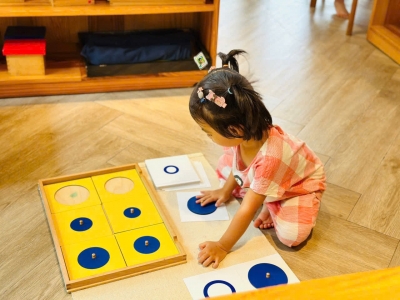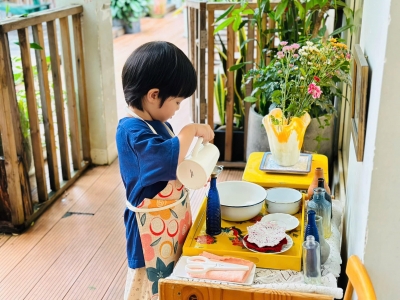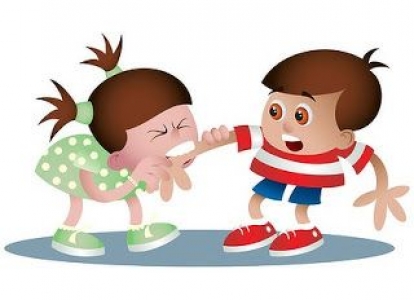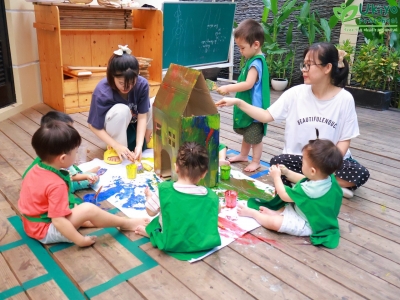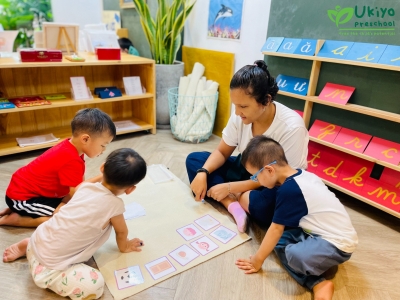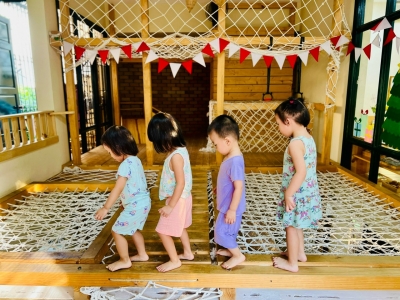To Develop Self-regulation Between 12-24 months
Toddlers have their own thoughts and strong emotions, which they express with great enthusiasm. "NO!" becomes a favorite word and a powerful way to assert their independence. At the same time, toddlers may become easily frustrated because there are many things they want to do but cannot yet accomplish. This second year of life can be challenging for both parents and children, as toddlers experience intense emotions that they are not yet able to regulate. Routines become particularly helpful during this period, as they provide a sense of security at a time when children often feel out of control.
Understanding Your Child’s Temperament
Temperament describes the unique way an individual perceives and responds to the world around them. Some children are flexible and "go with the flow," while others struggle with change. Some are highly outgoing, while others prefer to observe before engaging in new situations. These approaches to life are part of our temperament—innate characteristics we are born with. Temperament is neither created by parents nor chosen by the child.
A child’s temperament influences their ability to regulate emotions and cope with stressors. Children who are naturally more reactive, have a generally negative mood, or struggle with transitions may find it more difficult to develop self-regulation. Their emotions and reactions are so intense that self-control is simply harder to achieve. These children may require more time and guidance from you to develop coping strategies that allow them to self-soothe and regain control.
What You Can Do:
-
Look for patterns. Observe how your child reacts in different situations to better understand their temperament. How does your child handle change and challenges? What types of people and situations does your child gravitate toward or avoid? Identifying patterns can help you anticipate how your child will respond in certain situations. You can also recognize which experiences might be difficult for your child and help them prepare for them. Likewise, you can discover what soothes them and helps them navigate stress.
-
Validate your child's emotions. When your child is upset—perhaps a wheel has fallen off their toy car or their block tower has collapsed—let them know you understand their frustration. Resist the urge to immediately cheer them up. Instead of saying, "It’s okay, we’ll fix it," or "Let’s build it again," first acknowledge their feelings: "You’re frustrated that your tower fell down. That’s upsetting. You worked so hard on it." Offer comfort, such as a gentle back rub, and then help your child think through a solution. Acknowledging and accepting their emotions—known as empathy—helps children process difficult feelings and learn how to cope with them. Experiencing empathy also helps children develop the ability to empathize with others, which is a crucial aspect of forming healthy relationships.
[This recommendation is adapted from Building Healthy Minds by Greenspan: Six Experiences That Create Intelligence and Emotional Growth in Infants and Young Children. Click here to access our reference list and resources.]
Reflect on Your Own Temperament
Your temperament matters too. The degree to which a parent's temperament aligns with their child's is called "goodness of fit." For example, an introverted, reserved parent may struggle with an energetic, assertive child. Conversely, an outgoing parent might feel uncertain about how to support a shy, hesitant child. Taking the time to reflect on your own temperament can help you become aware of the "fit" between you and your child. Remember, even if you and your child are very different, you can still be an excellent and supportive parent. The key is to recognize your similarities and differences, which will help you understand your child's unique needs and support their development.
For example, an extroverted parent might initially encourage their shy child to jump right into a playgroup because that is their own natural response. However, by remembering that their child's approach to new situations is different, they can set aside their own instincts and support their child's needs. They might start by sitting at the edge of the playgroup, observing other children, and talking about what they are doing. Then, they might engage in solo play with their child and, after a few minutes, invite another child to join. Adjusting their approach in this way helps the parent support their child’s growing ability to manage emotions and develop self-regulation.
[This example is from Raising a Baby by Lerner and Dombro: Three Steps to Making Good Decisions in Your Child’s Early Years. For more, visit our resource and reference list.]
What You Can Do:
-
Pause before reacting. When faced with a stressful situation with your child, take a moment to pause and reflect on what is happening. What is your child communicating about their emotions and needs? How are you feeling and responding? This "pause"—even if just for a few seconds—allows you to choose the best approach for your individual child.
-
Model self-regulation. "I just spilled milk all over the floor! And we are late for storytime at the library! I feel so frustrated right now. I think I’ll close my eyes and count to five before cleaning up." Through your words and actions, you can show your child that regaining composure after a difficult moment is possible.
Set Realistic Expectations
Toddlers struggle with emotional and behavioral self-regulation because they are not yet able to:
-
Fully understand the consequences of their actions.
-
Distinguish between acceptable and unacceptable behavior.
-
Retain long-term memory of the limits and rules you set.
-
Control impulses to refrain from repeating undesired behaviors.
Because of these developmental limitations, punishment is ineffective and can cause fear and confusion.
What You Can Do:
-
Stop the behavior. For example, gently but firmly take your child’s hand and say, "No hitting. Hitting hurts," in a calm, serious tone.
-
Acknowledge their emotions. "You are very angry because Paolo took your toy. It’s okay to feel angry. But hitting is not okay. Hitting hurts."
-
Model appropriate ways to express emotions. Show your child alternative ways to express anger, such as jumping up and down, stomping feet, or hitting a cushion.
-
Help your child problem-solve. For example, help them approach Paolo to ask for their toy back or suggest using a timer to take turns.
See Misbehavior as an Opportunity to Teach Self-Regulation
Your toddler wants a cookie before dinner, to climb the stairs alone, to pull your earrings, or to bang a block against the window. They run full speed, trip and fall, or stick a finger in a kitchen drawer after pulling everything out. Each of these moments is an opportunity to help your child learn to manage frustration, disappointment, pain, and anger, while also teaching them what is and isn’t acceptable behavior.
Your response to these incidents will shape your child’s behavior. How you react determines whether your child sees a behavior as worth repeating. The stronger your emotional reaction—whether positive or negative—the more likely the behavior will persist, because your response reinforces it.
What You Can Do:
-
Use both words and actions to set limits. Verbal instructions alone may not be enough to stop an unacceptable behavior. Use a firm, authoritative (but not angry or yelling) voice. At the same time, reinforce your message with gestures such as "stop" or "no-no." Since toddlers primarily communicate through gestures, this "bilingual" approach is highly effective. Keep in mind that toddlers may not respond the first or second time; they need to hear and see the same limit repeatedly before fully understanding.
-
Acknowledge your child's intent. "You want to play with water, but you cannot pour your cup on the floor."
-
Redirect. Help your child achieve their goal in an acceptable way: "Throwing blocks is not okay; someone could get hurt. But you can throw these soft balls into a basket."
-
Provide alternatives. Show and explain what your child can do instead of focusing only on what they cannot do.
Help Your Child Learn to Self-Soothe
When a child loses self-control, they are showing you that they are no longer capable of coping. In this state of distress, they are unable to learn anything. Therefore, the goal in these moments is to help your child calm down so they can later focus on learning from the experience that led to their struggle.
Helping your child calm down is not giving in or spoiling them. It is teaching them an important skill. Sometimes, children can be soothed by being held tightly or rocked, as they need this kind of touch and physical contact to settle. This is fine and should not be seen as "giving in."
However, sometimes nothing seems to work. Our attempts to soothe them may even increase their distress. In these moments, alone time can be more beneficial. It gives the child a break and helps them regain their composure. However, this time alone should not be seen as a punishment. It is a positive tool that provides a healthy pause until the child can self-soothe.
What You Should Do:
-
Create a safe space in your home with comforting items like pillows, stuffed animals, and books. Some families call this their "calm corner." Let your toddler help set up this space. Explain that it is a special place for everyone in the family when they need a break.
-
Help your child learn to regulate their emotions and behavior by letting them know they can end their break when they feel calm and ready to engage again.
-
Model taking breaks. When you are struggling, feeling frustrated, or angry, go to the safe space yourself. This is an effective way to demonstrate self-control and show that sometimes you also need a break. It also teaches your child that the calm corner is not a punishment but a safe retreat.
Turn Tantrums into Teachable Moments There is rarely a dull moment in your child's second year, as toddlers begin expressing emotions enthusiastically—joy, excitement, anger, frustration, disappointment, and sadness. These emotions can be hard to manage even for adults, let alone a one-year-old! So, it's no surprise that tantrums start happening. Through tantrums, your child is telling you they are struggling to cope.
When responding to a tantrum, it is important to remember that young children do not enjoy feeling out of control. (Tantrums are not fun for them either!) Tantrums are both an emotional expression and a cry for help. Your child needs your support to calm down and regain control.
What You Should Do:
-
Stay calm. The calmer you are, the calmer your child will feel. If you lose control, it can distress your child even more.
-
Acknowledge your child's feelings but do not tolerate unacceptable behavior. Until a child feels understood, they may escalate their response to make sure they are "heard." When your child misbehaves, acknowledge their feelings, but make it clear that their actions—what they do with their emotions—are not acceptable. "I know you're really angry, but you cannot throw blocks." While your child may not fully understand your words at that moment, they will pick up on your serious tone and the actions that accompany your words. This helps them grasp the meaning of your words as they grow.
-
Help your child learn to self-soothe. Offer them a comfort object, such as a favorite toy or blanket, to hold during their tantrum. Play soft music. Provide a special space where they can "cool down," such as a cozy corner with pillows and stuffed animals or even a soft blanket under a table where they can curl up. Speak in a calm voice. Show them acceptable ways to express anger, like stomping feet, crumpling paper, hitting a cushion, or other healthy outlets. These methods are not indulgences or ways to spoil your child. (But giving them a cookie to stop crying would be.) They are strategies to help your child learn how to cope with frustration and disappointment in life.
-
Repair the connection. Find ways to reconnect with your child after a tantrum. Bring out their favorite books to read together. Offer a hug, a back rub, or hold their hand. Remember, your role is not to punish your child for their tantrum (which is a result of frustration), but to help them calm down afterward. This is how they will learn self-regulation.
-
Use natural consequences. Help your child understand that unacceptable behavior has natural consequences. If your child continues to throw blocks, you might say, "The blocks need to be put away because you are throwing them. We can play with them again tomorrow. Would you like to do a puzzle instead?"
Recognize That Sometimes Nothing Works
We all have moments when our child becomes extremely upset, throwing themselves on the supermarket floor with all eyes on us. This does not mean your child is "bad" or that these techniques do not work. It simply means that parenting is challenging and there are no easy answers. Sometimes, the best thing you can do is stay by your child's side until they calm down, so they know you are there for them. (And remind yourself that this too shall pass.)
Others



